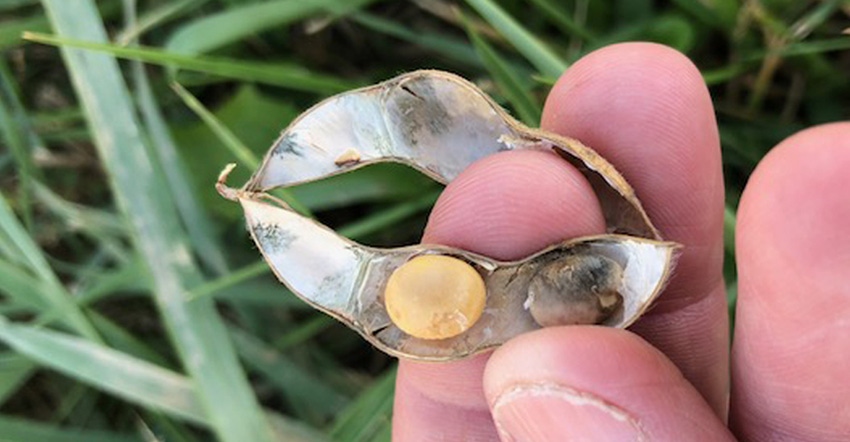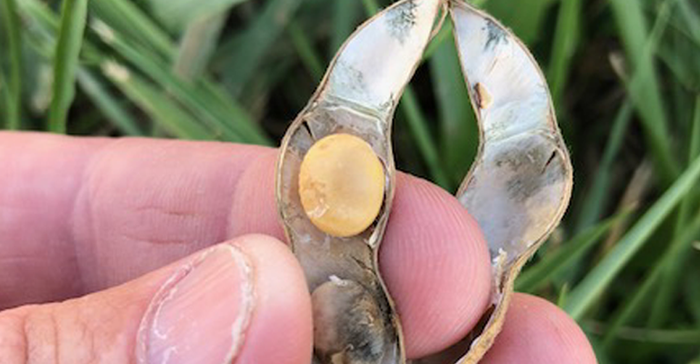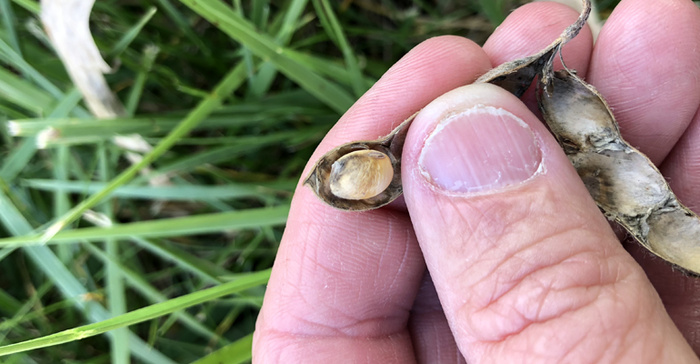November 1, 2018

Sponsored Content
For many farmers across the Midwest, soybean yields have been good to great, but the soybean quality has not been as promising. Uncharacteristically warm temperatures along with high rainfall and humidity as the soybeans matured have led to some ugly looking soybeans this fall. From disease to insect feeding and compromised pods, there are many factors that have taken a toll on soybean seed quality this year.
Disease
The unseasonably warm temperatures and high humidity during late August and September led to a significant Frogeye Leaf Spot (FLS) infection on the soybean pods themselves. Typically, we think of this disease as more damaging to soybean vegetation. However, with extremely high volumes of inoculum present, along with a favorable environment, pods were infected as well. As the FLS lesions continued to develop, they not only penetrated the pod wall infecting the soybeans, but also weakened or thinned the pod walls, allowing moisture to move into the pod cavity. Varieties more susceptible to vegetative infection of FLS had increased pod infection with the heightened inoculum levels.

Insect Damage
Stink bugs are a pest that we have seen for quite some time but may not have always felt like they had any impact on our yields. While that may be somewhat accurate, when it comes to soybean quality it’s a different story. Since stink bugs are typically not problematic until later in the growing season (near the R5 growth stage) it’s less likely to cause as much yield damage as earlier arriving pests or pathogens that hit at the R2 or R3 gorwth stage. Stink bugs are not “chewing” insects as they have piercing-sucking mouthparts. They cause injury to soybeans by puncturing pods and sucking fluid from the developing soybeans. Often times this leads to shriveled, light-weight soybeans. The injured pods allowed moisture from the excessive rainfall to contact the plants, resulting in soft, discolored soybeans.

Some of these same fields that experienced poor soybean seed quality recieved a fungicide/insecticide application at or around the R3 growth stage. So why didn’t these applications seem to make a difference? Many of the fungicide products we use today provide approximately three to four weeks of activity. It’s likey that too much time had elapsed between the R3 fungicide application in mid- to late-July to provide significant fungal suppression in late August and September. The R3 growth stage application may have also reduced inoculum levels, but overall protection could not be expected as the soybeans were near maturity. Also, as referenced above, stink bug populations typically do not cause significant impact until much later, around R5, or the beginning of seed fill. By this time the insecticide component had already run its course in terms of effectiveness.
Compromised or Open Pods
During the month of July, much of the midwest experienced drier growing conditions. This is when many early-planted soybeans began pod formation. Hot, dry weather throughout the month of July, followed by average to above average rainfall in August and early September caused soybean cavities to be disproportional to soybean seed size. Adequate to excessive rainfall led to very large soybean size in many cases, resulting in stretched pods that allowed moisture to enter. Lastly, many soybeans harvested in late September and early October had been mature for some time, but field conditions prevented us from harvesting them. This resulted in ripped and broken soybean pod sutures (pod seams) from the continued wetting and drying cycles.
For many farmers across the midwest, Mother Nature was kind in terms of overall yields in 2018. However, she also dealt some rough hands as the growing season concluded, resulting in less than desirable soybean seed quality.
About the Author(s)
You May Also Like




